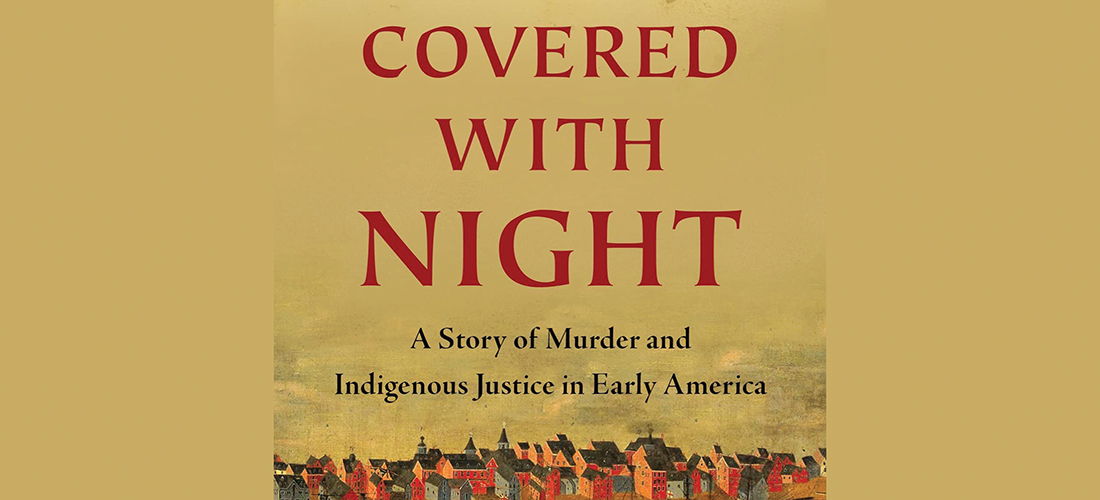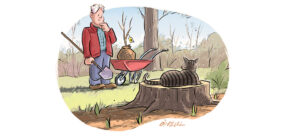
Balancing the Scales
Justice among disparate peoples in Colonial America
By Stephen E. Smith
Humorist Edgar Wilson “Bill” Nye is credited with saying: “Wagner’s music is better than it sounds.” Readers of popular history who tough their way through 464 pages of Nicole Eustace’s Covered with Night: A Story of Murder and Indigenous Justice in Early America will likely be left with the notion that what they’ve read is more profound than entertaining.
“Covered with Night” is an Iroquois expression describing the state of grief or mourning inspired, in this instance, by the 1722 murder of a Native American man who lived near Conestoga, Pennsylvania, a small community north of the Maryland-Pennsylvania border. Details of the fatal encounter are straightforward and commonplace: English merchants John and Edmund Cartlidge were bargaining with Sawantaeny, a Seneca hunter and fur trader, when an overindulgence in alcohol, probably by all parties concerned, led to a disagreement. Sawantaeny went for his rifle, but John Cartlidge disarmed him and bashed in the Seneca’s skull.
“My friends have killed me,” were Sawantaeny’s last words.
Such incidents, terrible though they may be, are not an uncommon aspect of human interaction, but in the early 1700s, a period in America’s past that is strangely deficient from the history we’ve been taught (we learn about the Lost Colony, Jamestown, Plymouth and mysteriously we jump to the Boston Harbor Tea Party), such a death had far-reaching ramifications for the Native American and Colonial communities. Covered with Night explores the causes and consequences of the Cartlidges’ ill-advised assault on Sawantaeny, while illuminating the fundamental flaws in the relationships that existed between the Native American and Colonial cultures.
Eustace’s complex treatise was made possible by the meticulously documented speeches of a Native man called “Captain Civility,” who reacted to the death of Sawantaeny by attempting to strengthen the tenuous bonds that existed between the competing cultures, and Eustace was able to draw on earlier studies by 20th century ethnographers and on postmodern analyses on social and criminal justice. If all of this sounds complicated, it is.
Investigations of Sawantaeny’s murder by Native American leaders and Colonial officials initiated a debate about the very nature of justice and its cultural context. Colonial authorities were fearful that the murder might bring on a full-scale war, endangering the white population and disrupting trade. The crisis was serious enough that news of it reached the British Board of Trade in England, resulting in a region-wide treaty conference that produced an obscure document signed at Albany in 1722 between members of the Five Nations of the Haudenosaunee and representatives from the colonies of New York, Pennsylvania, and Virginia. It remains the oldest recognized treaty in the history of the United States. Much more than a simple diplomatic instrument, the treaty records a foundational American debate over the nature of justice.
Avoiding conflict with their Indigenous neighbors was the foremost concern of the Colonial authorities, and they held the Cartlidge brothers in irons pending their execution — which is exactly what the Native Americans hoped to avoid. Pennsylvania Gov. William Keith was dismayed to learn that sending the Cartlidges to the gallows was counter to the Native American notion of justice. Native diplomats Satcheechoe and Taquatarensaly asked that the Cartlidges be released from prison and from the threat of execution. They preferred that Keith journey to meet with the leaders of the Five Nations to “cover the dead” by offering reparations and performing mourning rituals that addressed their grief — all of which ran counter to Colonial assumptions about what constitutes civilized retribution.
The Iroquois weren’t “savages,” as characterized by the Colonial authorities. They were possessed of a humanity that tied them to the land and their communities, and they saw the murder as an opportunity to establish stronger and more lasting bonds with their Colonial neighbors. They wanted their collective grief assuaged emotionally and accounted for economically.
“Colonists were so unprepared for Native offers of clemency, a total inversion of their expectations, that they made little deliberate note of the philosophy that informed Native policy,” Eustace writes. “Indigenous ideals entered the record made at Albany almost inadvertently, the by-product of colonial desires to document the land and trade agreements that would further Pennsylvania’s prosperity and security. Still, colonists dutifully wrote down the speeches that Captain Civility and other Native speakers made to them. And in the process, they preserved Indigenous ideas on crime and punishment, violation and reconciliation.” Negotiations were complicated by barriers of language and dialect. Various Native American tongues had to be translated from one Indigenous speaker to another until the words evolved into a concept that could be realized in standard English.
If Eustace’s explication of events is occasionally academic, it’s also thought-provoking, requiring patience and commitment on the part of the reader. Attempts to energize the narrative by using present tense, and a somewhat awkward fictional attribution of motivations to characters whose true emotions are unknowable, only serve to lengthen and diminish the story: “Seated at his table, William Keith warms the bottom of a stick of vermilion sealing wax,” she writes. “He feels the heat but will take care not to burn his fingers. In a quiet room, a dollop of wax makes a soft splotch as it hits paper, round and red as a drop of blood. Keith lets the wax cool a moment from liquid to paste, then presses smartly with his seal to emboss the wax with an intricate pattern of scrolls.”
Eustace also includes detailed descriptions — furniture, dwellings, the travails of daily living, concepts surrounding indentured servitude and slavery — that enhance the reader’s knowledge of an otherwise obscure period in our history. But her primary contribution is the reclamation of alternative concepts of crime, punishment and the mitigation of grief that are no longer components of contemporary life. PS
Stephen E. Smith is a retired professor and the author of seven books of poetry and prose. He’s the recipient of the Poetry Northwest Young Poet’s Prize, the Zoe Kincaid Brockman Prize for poetry and four North Carolina Press Awards.





